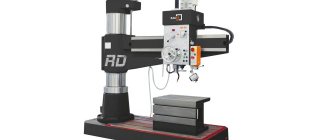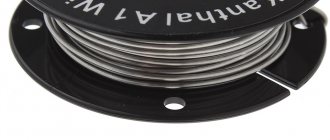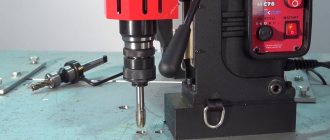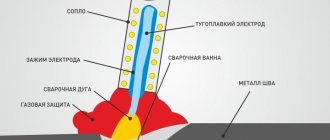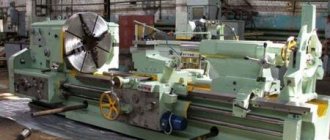Pincers and forceps are the most ancient devices known since prehistoric times. According to historians, they were initially used in blacksmithing, but very quickly formed a large group of pliers. Today, the number of varieties of such devices is very large; not every master can list them all at once. They are usually called pliers or pliers, although almost every design option has its own name.
It is noteworthy that significant changes in the design of such instruments have not been made for a very long time, despite noticeable changes in the appearance of other devices. In addition, the specific use does not imply the creation of a power tool from these devices. Let's take a closer look at them.
What are pliers and pliers?
1-Pliers 2-Pliers
Both types are the most common and extensive types of pliers. They all have a similar design - two identical (most often) elements connected by a hinge. On one side there are handles, the other part is the working part.
The difference between all types consists of two positions:
- Sponge shape . This indicator determines the name and purpose of the tool.
- Hinge type . The classic type is a fixed hinge, but detachable options are often found that allow you to change the size of the working base (the grip width of the jaws).
The purpose of the tool is determined by the shape of the jaws. It can have cutting edges, cutouts that provide a stronger and tighter grip, and form a kind of template for bending various parts.
The following varieties exist:
- Pliers.
- Pliers.
- Wire cutters.
- Side cutters.
- Round nose pliers.
- Long nose pliers.
- Needle nose pliers.
- Ticks.
Expert opinion
Levin Dmitry Konstantinovich
In everyday life, any type of tool at the disposal of a craftsman is often called pliers. This is wrong, but it is not important for a home master. However, when communicating between specialists or in a store, you should be precise and understand the differences between the tools.
Types of pliers
Types of clamping pliers
Depending on the design and purpose, clamping pliers come in the following types:
- Dielectric – designed to work with electrical installations under voltage up to 1000V;
- Installation - designed for convenient and quick removal of insulation from wires. At the end of the clamping head of such a tool there is a stripper - a device for stripping the conductor from the insulating layer.
- Curved combined - have jaws curved at an angle of 30-900. Used for fixing various parts or conductors in confined spaces.
- Platypuses are instruments with narrow and long jaws that have a pointed wedge-shaped shape;
- Elongated - are improved platypuses, having straight, thin sponges of great length
- Reinforced - clamping pliers that, compared to analogues, have a reinforced design (greater thickness and strength of the levers), allowing for forceful clamping and holding of various parts and objects.
- Mini-pliers are small, no more than 12 cm in length, they allow you to work with fragile parts and objects that require delicate handling;
- Energy-saving type - thanks to the reinforced hinge mechanism for attaching the levers, this type of tool allows you to apply 30-40% less force when fixing various objects, compared to using analogues;
- Lever - have a special lever mechanism for fixing the jaws, which allows you to increase the fixation force of an object or part held with such a tool;
- With increased levers – characterized by levers of significantly greater length than analogues. Used for fixing and holding large and heavy parts.
- Folding - a multi-tool (multi-tool), which, in addition to the clamping pliers themselves, includes a small screwdriver, knife, corkscrew, file, bottle opener, etc.
- Adjustable pliers - have two levers that overlap each other. Thanks to the movable mounting of the levers in the longitudinal plane, they are characterized by an adjustable working width.
- Clamping - working on the principle of a clamp and allowing you to fix parts or objects using a knee-lever mechanism and an adjusting screw installed on the handles of the pliers levers.
- Pliers for removing caps - pliers used for unscrewing the caps of fuel tanks of trucks and other heavy special equipment;
- Locksmith - simple and reliable, used for various types of locksmith work, which do not involve contact with live conductors and live surfaces;
- Electrician's pliers - made of dielectric material, designed to work with conductive surfaces;
- Fishing tools are a compact tool with thin jaws, comfortable handles, and a flexible connection to a belt or carabiner on clothing using a durable plastic cable.
Tags: , sconce, view, choice, house, , clamp, sign, how, design, , installation, voltage, crimping, rule, principle, wire, start, , work, size, repair, row, connection, means, deadline , ten, type, current, , installation, shield, electricity
Difference between pliers and pliers
The difference between both types is not fundamental, but quite definite.
Pliers are designed for gripping, squeezing, and bending various parts or workpieces. The working surfaces are straight, usually with fine corrugation to prevent the material from slipping when gripping.
Pliers are a universal tool. They are capable of performing a significantly larger number of operations and tasks, since their jaws are equipped with various recesses, grips, and cutting edges on both the inside and outside.
A typical set of functionality typical of pliers:
- Capturing, clamping parts.
- Bending wire or sheet metal.
- Biting wire, nails, screws, etc.
The versatility of pliers makes them the main type of pliers. They are used by electricians, mechanics, technicians, and other specialists. Due to their capabilities, they are included in the mandatory set of tools and devices required to perform most technical or construction tasks. Often pliers are equipped with additional tools - a grip on the other side of the hinge, auxiliary devices at the ends of the handles (screwdriver or awl). The demand and popularity of the instrument is confirmed by the large selection of manufacturers and models available on store shelves.
Features, technical specifications
The main technical characteristics of pliers and pliers are:
- Size (total). Usually ranges from 10 to 20 cm.
- Width of jaws. standard - 2-3 cm.
- Opening angle of working surfaces. Depends on the type of hinge and specific design features.
- Set of functions (for pliers). The presence of cutting surfaces, the ability to cut through steel wire using a groove on the outer surface of the jaws, a return spring, etc.
- Hinge type. There are fixed or adjustable designs
- Availability of rubber, PVC or plastic linings for handles
- View
- Coatings: Tools are available in chrome or blued finish.
The main feature of the tool is the presence of two handles that perform dual functions:
- Used for holding in hands.
- Adjust the amount of opening and compression force of the jaws.
Expert opinion
Levin Dmitry Konstantinovich
Working with insulated handles allows you to protect yourself from electric shock and provides comfort when using the tool in severe frost. However, there are pliers and pliers that do not have additional elements. They are usually used for working with hot objects when the safety of the handles cannot be ensured. In such situations, hand protection is necessary - mittens, suede gloves, etc.
What is the difference between pliers and pliers: the main parameters of the tools
According to the interpretation of GOST, pliers are a tool designed to grip and clamp pipes and parts of various shapes. Externally, the products are very similar to pliers. They are equipped with flat jaws, which are an extension of the working area for gripping bolts or tubes. In addition, the tools presented are most often equipped with side cutters to remove insulation.
Let's take a closer look at the difference between pliers and pliers.
Pliers and pliers have different working surface shapes.
The following features of these tools should be noted:
- the ability to adjust the gap of the working surface of the jaws and the degree of force of the product by rearranging the hinge is provided only for pliers;
- pliers are tools designed to perform only one action, while pliers are multifunctional products;
- pliers are equipped with wire cutters for cutting thin wire; high-strength steel is used in their manufacture;
- often pliers are characterized by a flat working surface with a notch along the entire length.
On a note! On the modern market you can also find 200 mm combination pliers, but this is the exception rather than the rule.
In addition, it is worth noting that the design of the pliers is designed for greater compression force. This means that manufacturers select the appropriate grade of material for these products—one that is characterized by a greater degree of strength.
Perhaps the most significant difference between pliers and pliers is that the former provide the ability to solve a larger number of different everyday tasks. In many ways, they can be an excellent replacement for end cutters, small house vices or side cutters, gripping almost any small-sized object.
With pliers, the width of the jaws along the entire length is always the same, unlike pliers.
Pros and cons of the tool
The advantages include:
- Multifunctionality, versatility of use, ability to perform various tasks.
- Compact, light weight, easy to carry the tool with you.
- Wide choice of size, shape, additional functionality.
- Affordable price.
Flaws:
- The metal is prone to corrosion, so it is necessary to organize appropriate conditions for storing the tool.
- The fixed hinge is subject to loss of mobility and requires periodic lubrication.
- The handles wear out quite quickly and require replacement.
The disadvantages can be considered design features, since they are equally inherent in all pliers. The high demand and demand for pliers and pliers is well confirmed by the presence of one or several copies for every specialist and home craftsman.
Criterias of choice
You can choose a high-quality and convenient tool based on the following criteria:
- Purpose, main tasks to be solved. Determine the size and width of the sponges, check the comfort of the hand grip and other organoleptic indicators;
- Set of functions. For electricians, it is important to have insulating pads on the handles. In addition, it is necessary to inspect the working part and find out what operations are available when using this instance. It is recommended to choose the most multifunctional tool possible, although some additional functions may be redundant;
- The color of the handles should be bright enough so that you can immediately find them in low light conditions;
- The tool manufacturer must be well-known and reliable. There are a large number of products from Southeast Asian countries on the market. They do not provide sufficient strength and are made from the wrong steel. Sometimes the handles or jaws of such specimens simply break during operation. It’s better to pay more, but get a high-quality and durable tool;
- There are household and professional pliers. The first ones are produced for home use, are not durable and are intended for occasional use. The latter are noticeably more expensive, but fully meet all quality requirements. It is recommended to give preference to professional samples that are guaranteed to perform all available tasks;
- It is necessary to check the tool by squeezing the handles. Ideally, the jaws should compress tightly, without gaps. The cutting edges are adjacent to each other. The movement of the jaws is soft, without resistance.
Expert opinion
Levin Dmitry Konstantinovich
You should not save on buying a tool. The result will be the need to soon go to the store again and spend money again, so it is better to immediately choose a high-quality copy, even if it is somewhat more expensive than other varieties.
Popular makes and models
The number of manufacturers producing various types of pliers is very large. When purchasing, you may find yourself in a situation where all offers are of good quality and functionality.
Let's consider several popular models:
KNIPEX KN-0306160
A tool with dielectric pads that can withstand voltages up to 1000 V. The shape of the jaws is narrowed towards the end to make it easier to work in hard-to-reach places. There are cutting surfaces and a cutout for comfortable grip of round parts.
INFORCE 200 mm 06-18-03
A convenient tool for working with electrical wires. On the cutting edges in the upper part there is a special cutout that keeps the wire itself intact, cutting only the insulation. The large size (20 cm) provides access to terminals or other parts in hard-to-reach places.
NWS CombiMax 180mm, C5.2, H2.2, K12
An excellent choice for installers of metal containers, panel elements and other work with threaded fasteners. The side cutters are combined with a special gear-type crimp that securely holds the bolt head. Comfortable handles with a projection for one-handed operation.
Delo Techniki 413160 160 mm
Lightweight and convenient tool with massive stops on the top of the handles to prevent slipping. Optimal for installation work in narrow, hard-to-reach places. Weight is only 150 g. The shape of the jaws is narrow, curved, making it easier to install small elements.
STANLEY CONTROL-GRIP 200 mm
Classic-type pliers with comfortable insulated handles. Manufactured from carbon steel and easy to move. The weight is quite large - 400 g, which is explained by the strength and reliability of the tool.
MATRIX 16906, 200 mm
An optimal and compact example of pliers suitable for any work. They have all the necessary functions and are equipped with a groove for cutting wire on the outer sides of the jaws. Tool weight: 380 g.
NIH 2212-1-20
Pliers, which belong to the group of household tools, but in terms of functionality and quality are practically no different from professional ones. They have high stops on the handles, precise and tight connection of the jaws, and have cutters and a groove for cutting nails or wire. With a large length (20 cm) they weigh only 290 g.
Ombra 400107
A convenient tool with a smooth ride thanks to the abundant lubrication of the hinge. The handle covers have a two-component design with an anti-slip coating on the outside. With a length of 18 cm, the tool weighs 200 g. The side edges can cope with wire up to 3 mm thick.
WEDO 160 mm 41-160/30R7
The pliers are distinguished by precise German assembly, which allows you to securely clamp the thinnest materials. Made from C60 tool steel. The weight of the instrument is 300 g. Among the disadvantages is the relatively high price.
KNIPEX KN-0202180
Expensive professional tool made of tool steel 63 HRS. It undergoes forging and heat treatment, which makes the cutting edges capable of cutting through the hardest materials, even piano wire. In addition, the length of the side cutters allows you to work with cables up to 11 mm thick. Based on test results, it was determined that working with these pliers requires 35% less effort.
It is impossible and impractical to list all the quality tools. The number of offers on the market is too large. When purchasing, you should consult with a consultant who can recommend the most suitable option for existing conditions.
Rating of pliers
For long-term use, it is recommended to get acquainted with popular models that have proven themselves well. These include:
- BAHCO 8285
. Adjustable device made in France. Used to perform installation work with workpieces of different sizes. Material – alloy steel. - ProsKit PM-912
. Dielectric reinforced pliers. Material – high-strength tool steel coated with Teflon film. - Pliers Knipex KN-0306160
. Material – tool steel, oil-hardened. Used for high voltage work. - Gross 16973
. Combination products can be used as a wrench. There are additional stops on the bottom. - NWS 109-69-165
. Dielectric tool for cutting various wires. The shape of the lips is straight. - BRIGADIER 21004
. Combination pliers. The shape of the sponges is straight. Manufacturing material – polished carbon steel. - Total THT210706S
. High-strength products from a Chinese manufacturer. The working surface is made of chrome vanadium alloy, black coated and polished. - NWS CombiMax
. Equipped with reinforced lever transmission. There are protrusions at the ends of the handle. The lips are narrowed. - STANLEY CONTROL-GRIP
. The most popular type of pliers. Handle covers are two-component. Product length 20 cm. - Ombra 400107
. The best budget model with a soft ride. Suitable for working with small parts.
Tips from experienced users
To increase the service life of the tool, you should not use it for unusual work. Sometimes pliers are used as a stand when riveting metal parts with a hammer, or to hold live contacts. This leads to loosening of the hinge, and a strong spark when the contacts open can melt the jaws like welding. It is necessary to lubricate the pliers in a timely manner, wipe them from moisture with a rag, and clean them from aggressive chemical compounds. A careful and careful attitude will help keep the linings on the handles intact and increase the overall service life of the tool.
Which tool do you use most often?
PliersPliers
They are used for
Although these instruments are characterized by almost the same external similarity, they actually have serious differences from each other. Moreover, the production of each tool is strictly regulated by its own standards, both in Russia and in the world (GOST and ISO, respectively).
Using pliers, you can perform the following actions:
- bend metal products;
- twist and, conversely, unscrew threaded connections;
- twist the wires;
- cut the wire;
- pull out nails;
- use as an aid when driving;
- use as an element holder.
You may be interested in Checking the Ku202n thyristor
Everything must be up to standard

